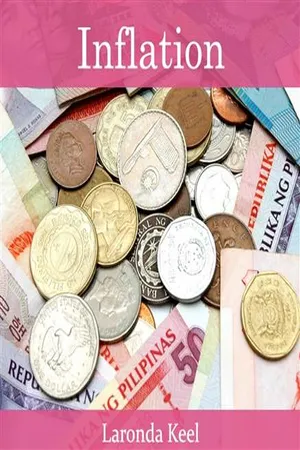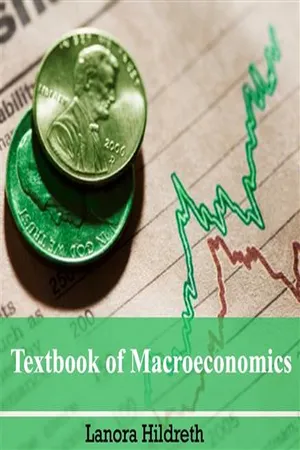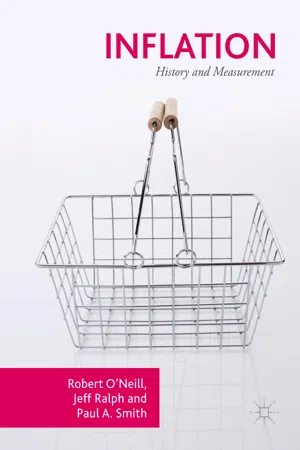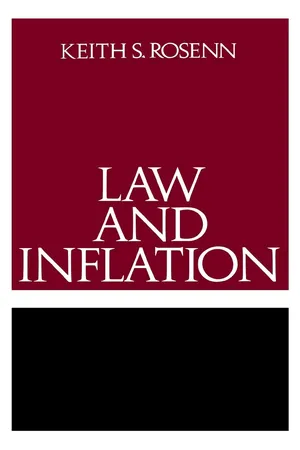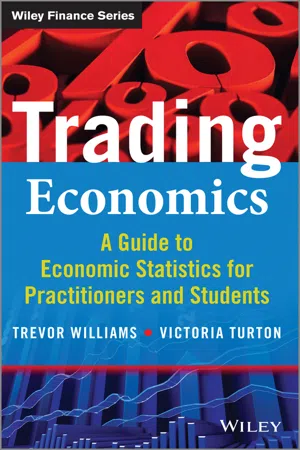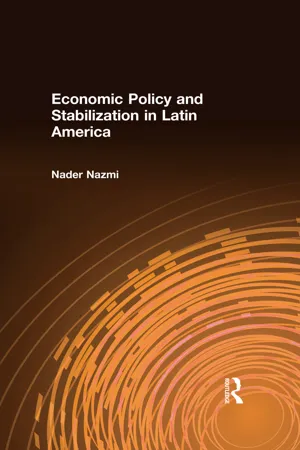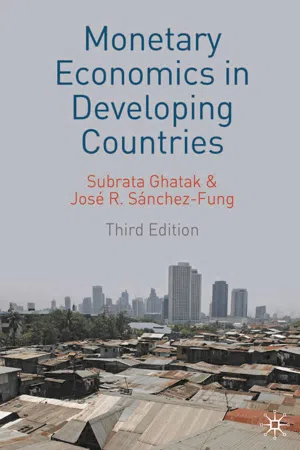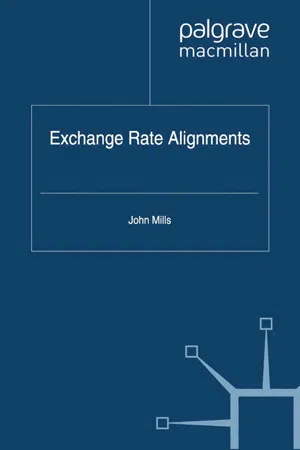Economics
Consequences of Inflation
Consequences of inflation refer to the effects of a sustained increase in the general price level of goods and services in an economy. These consequences can include reduced purchasing power, uncertainty for businesses and consumers, redistribution of wealth, and potential negative impacts on savings and investment. Inflation can also lead to higher interest rates and decreased international competitiveness for a country's exports.
Written by Perlego with AI-assistance
Related key terms
1 of 5
12 Key excerpts on "Consequences of Inflation"
- No longer available |Learn more
- (Author)
- 2014(Publication Date)
- Orange Apple(Publisher)
____________________ WORLD TECHNOLOGIES ____________________ Chapter- 1 Inflation In economics, inflation is a rise in the general level of prices of goods and services in an economy over a period of time. When the general price level rises, each unit of currency buys fewer goods and services. Consequently, inflation also reflects an erosion in the purchasing power of money – a loss of real value in the internal medium of exchange and unit of account in the economy. A chief measure of price inflation is the inflation rate, the annualized percentage change in a general price index (normally the Consumer Price Index) over time. Inflation's effects on an economy are various and can be simultaneously positive and negative. Negative effects of inflation include a decrease in the real value of money and other monetary items over time, uncertainty over future inflation may discourage investment and savings, and high inflation may lead to shortages of goods if consumers begin hoarding out of concern that prices will increase in the future. Positive effects include ensuring central banks can adjust nominal interest rates (intended to mitigate recessions), and encouraging investment in non-monetary capital projects. Economists generally agree that high rates of inflation and hyperinflation are caused by an excessive growth of the money supply. Views on which factors determine low to moderate rates of inflation are more varied. Low or moderate inflation may be attributed to fluctuations in real demand for goods and services, or changes in available supplies such as during scarcities, as well as to growth in the money supply. However, the consensus view is that a long sustained period of inflation is caused by money supply growing faster than the rate of economic growth. Today, most mainstream economists favor a low steady rate of inflation. - No longer available |Learn more
- (Author)
- 2014(Publication Date)
- White Word Publications(Publisher)
____________________ WORLD TECHNOLOGIES ____________________ Chapter-7 Inflation In economics, inflation is a rise in the general level of prices of goods and services in an economy over a period of time. When the general price level rises, each unit of currency buys fewer goods and services. Consequently, inflation also reflects an erosion in the purchasing power of money – a loss of real value in the internal medium of exchange and unit of account in the economy. A chief measure of price inflation is the inflation rate, the annualized percentage change in a general price index (normally the Consumer Price Index) over time. Inflation's effects on an economy are various and can be simultaneously positive and negative. Negative effects of inflation include a decrease in the real value of money and other monetary items over time, uncertainty over future inflation may discourage investment and savings, and high inflation may lead to shortages of goods if consumers begin hoarding out of concern that prices will increase in the future. Positive effects include ensuring central banks can adjust nominal interest rates (intended to mitigate recessions), and encouraging investment in non-monetary capital projects. Economists generally agree that high rates of inflation and hyperinflation are caused by an excessive growth of the money supply. Views on which factors determine low to moderate rates of inflation are more varied. Low or moderate inflation may be attributed to fluctuations in real demand for goods and services, or changes in available supplies such as during scarcities, as well as to growth in the money supply. However, the consensus view is that a long sustained period of inflation is caused by money supply growing faster than the rate of economic growth. Today, most mainstream economists favor a low, steady rate of inflation. - eBook - PDF
Inflation
History and Measurement
- Robert O'Neill, Jeff Ralph, Paul A. Smith(Authors)
- 2017(Publication Date)
- Palgrave Macmillan(Publisher)
22 R. O’Neill et al. 2.1 Why Does Inflation Matter? Imagine trying to negotiate a pay rise with your boss without knowing what the recent level of inflation has been. You might tell your boss that the cost of the things you buy has increased over the course of the past year, while they might argue that their experience has been that prices are falling. If we then abstract this argument to a broader level and con- sider the bargaining positions of unions and management teams, it may help to make it clear what might be a sensible wage increase to maintain the purchasing power of workers’ wages. 1 Such concerns do not only affect those working but also affect those in receipt of benefits. A pen- sioner who is given a pension on retirement will see their ability to pur- chase consumer goods fall if price levels rise, and so they are likely to be keen to make sure that benefit payments keep pace with changes in the level of prices in a given area during a given passage of time. 2.2 The Language of Inflation Before moving on it is useful to consider the common definition of inflation and the definitions of related terms as they are commonly understood by economists, who are likely to make the most frequent use of such terms. The OED definition of inflation (relating to economics) is that it defines a general increase in prices and a fall in the purchas- ing value of money, see OED (2017). Similar definitions of inflation are offered by some of the leading textbooks aimed at students of econom- ics 2 although their focus is much more on the first part of this defini- tion—that inflation is defined as a general increase in price levels. For many people, a definition of inflation as the increase in the price levels experienced in an economy may be enough for them to be happy that they understand it. - R. Albert Berry(Author)
- 2019(Publication Date)
- Routledge(Publisher)
Hence, the double importance of judging how inflation affects distribution. There are many reasons to believe that the effects of a continuous and, there-fore, generally anticipated inflation on the real values of economic variables would be different from those of an unanticipated one, usually synonomous with an acceleration of the rate of price increase. Under some conditions in theory an anticipated inflation would have little effect on real variables, although in a devel- EFFECfS OF INFLATION 115 oping country like Colombia with many market imperfections even a fully pre-dicted and stable level of inflation may have significant distributional effects. When inflation is above 5 percent, the rate is seldom stable for long; hence dis-cussions of the impact of inflation on output, distribution, or whatever, are usually discussions of changes in the rate of inflation. Since the rate of price in-crease is not the same in all sectors, relative prices change during the course of an inflationary period; thus, food prices may rise quickly when the rate of in-crease of the general price index is accelerating while rents may lag, but in the subsequent deceleration the opposite may be true. These changes in relative prices may be important for an analysis of the income distribution effects of inflation, since persons at different income levels purchase different bundles of goods. If an unanticipated increase in the rate of inflation worsened distribution and an unanticipated decrease improved it, a burst of rapid inflation followed by a return to the normal level (to which the system has become accustomed) might affect distribution as indicated in Figure 4.la; i.e., in the same direction but with some lag. The total impact is different at different points of time and must be described accordingly; after the cycle has been completed, distribution might be better (as shown in the figure) or worse-this being a matter requiring demonstra-tion.- eBook - PDF
- Keith S. Rosenn(Author)
- 2015(Publication Date)
- University of Pennsylvania Press(Publisher)
INFLATION'S CAUSES AND CURES The term inflation is often used loosely in English to mean anything from pomposity to increases in money, income, and profits. 1 For the pur-poses of this book, inflation is used to refer either to a sustained rise in an economy's general level of prices or to a corresponding fall in the domestic purchasing power of an economy's currency. This working definition im-plies that inflation is a dynamic process in which the aggregate level of prices is moving upward over time while the purchasing power of money is in corresponding decline. It does not mean that all prices are moving upward uniformly, nor even that all prices are moving upward. It does mean that an economy is undergoing inflation when it presently costs more to purchase a representative sample of goods than it cost in the past. Inflation and its opposite, deflation, describe changes in a nation's internal price levels or its currency's domestic purchasing power. Changes in a currency's external purchasing power occur through adjust-ments in the foreign exchange rate. When the value of country A's cur-rency declines relative to the currency of country B, there has been a devaluation of country A's currency. Correspondingly, there has been an upward revaluation in country B's currency relative to country A. In com-mon parlance references to changes in internal and external purchasing power of a currency are frequently commingled; it is not uncommon to find courts confusingly referring to devaluation when they really mean depreciation in domestic purchasing power. 2 In the long run, countries experiencing inflation rates higher than those of customary trading part-ners will be forced to devalue; however, in the short run, it is frequently possible for countries to maintain the same exchange rate despite sub-stantial domestic inflation, or to devalue by less than the inflation rate differential. - eBook - PDF
Trading Economics
A Guide to Economic Statistics for Practitioners and Students
- Trevor Williams, Victoria Turton(Authors)
- 2014(Publication Date)
- Wiley(Publisher)
4 Inflation Inflation is always and everywhere a monetary phenomenon in the sense that it is and can be produced only by a more rapid increase in the quantity of money than in output. Milton Friedman 1 WHAT IS INFLATION? Inflation tells us the changing (increasing) price of a range of goods or services; basically how much of something we can get for our money. The rate of change of prices – the speed at which the price of goods and services that are bought by households or businesses alter – is called inflation. But prices can also fall, in a process called deflation, sometimes termed negative inflation. Inflation is more common than deflation, or at least it has been in the last 50 years or so, and so it has become associated with changes in the price of goods and services. Historically, however, price falls were as common as price rises, as we will see later. Both inflation and deflation have advantages and disadvantages, which we will explore in more detail later in this chapter. THE HISTORY OF INFLATION Inflation has been around for a long time, but, as Figure 4.1 shows, the level of prices (the index) really only rose consistently and sharply in the UK from the 1970s onwards. This was after the US came off the gold standards and the Bretton Woods system of fixed exchange rates, which had prevailed after the Second World War, ended. Money was now backed by government fiat and trust rather than by gold. And exchange rates were no longer fixed but allowed to float freely. This seems to have led to a rapid rise in the level of prices or, in other words, to the Retail Prices Index. Before that, for hundreds of years, the level 1 Friedman, M., The Counter-Revolution in Monetary Theory (1970). 100 Trading Economics Retail Price Index (1987 = 100) 0 10 20 30 40 50 60 70 80 90 100 1264 1296 1328 1360 1392 1424 1456 1488 1520 1552 1584 1616 1648 1680 1712 1744 1776 1808 1840 1872 1904 1936 1968 2000 Figure 4.1 Price index over time. - eBook - PDF
- David Shapiro, Daniel MacDonald, Steven A. Greenlaw(Authors)
- 2022(Publication Date)
- Openstax(Publisher)
In many countries, the memory of double-digit, triple-digit, and even quadruple-digit inflation is not very far in the past. 9.4 The Confusion Over Inflation LEARNING OBJECTIVES By the end of this section, you will be able to: • Explain how inflation can cause redistributions of purchasing power • Identify ways inflation can blur the perception of supply and demand • Explain the economic benefits and challenges of inflation Economists usually oppose high inflation, but they oppose it in a milder way than many non-economists. Robert Shiller, one of 2013’s Nobel Prize winners in economics, carried out several surveys during the 1990s about attitudes toward inflation. One of his questions asked, “Do you agree that preventing high inflation is an important national priority, as important as preventing drug use or preventing deterioration in the quality of our schools?” Answers were on a scale of 1–5, where 1 meant “Fully agree” and 5 meant “Completely disagree.” For the U.S. population as a whole, 52% answered “Fully agree” that preventing high inflation was a highly important national priority and just 4% said “Completely disagree.” However, among professional economists, only 18% answered “Fully agree,” while the same percentage of 18% answered “Completely disagree.” The Land of Funny Money What are the economic problems caused by inflation, and why do economists often regard them with less concern than the general public? Consider a very short story: “The Land of Funny Money.” One morning, everyone in the Land of Funny Money awakened to find that everything denominated in money had increased by 20%. The change was completely unexpected. Every price in every store was 20% higher. Paychecks were 20% higher. Interest rates were 20 % higher. The amount of money, everywhere from wallets to savings accounts, was 20% larger. This overnight inflation of prices made newspaper headlines everywhere in the Land of Funny Money. - eBook - PDF
- Steven A. Greenlaw, David Shapiro, Daniel MacDonald(Authors)
- 2022(Publication Date)
- Openstax(Publisher)
In many countries, the memory of double-digit, triple-digit, and even quadruple-digit inflation is not very far in the past. 22.4 The Confusion Over Inflation LEARNING OBJECTIVES By the end of this section, you will be able to: • Explain how inflation can cause redistributions of purchasing power • Identify ways inflation can blur the perception of supply and demand • Explain the economic benefits and challenges of inflation Economists usually oppose high inflation, but they oppose it in a milder way than many non-economists. Robert Shiller, one of 2013’s Nobel Prize winners in economics, carried out several surveys during the 1990s about attitudes toward inflation. One of his questions asked, “Do you agree that preventing high inflation is an important national priority, as important as preventing drug use or preventing deterioration in the quality of our schools?” Answers were on a scale of 1–5, where 1 meant “Fully agree” and 5 meant “Completely disagree.” For the U.S. population as a whole, 52% answered “Fully agree” that preventing high inflation was a highly important national priority and just 4% said “Completely disagree.” However, among professional economists, only 18% answered “Fully agree,” while the same percentage of 18% answered “Completely disagree.” The Land of Funny Money What are the economic problems caused by inflation, and why do economists often regard them with less concern than the general public? Consider a very short story: “The Land of Funny Money.” One morning, everyone in the Land of Funny Money awakened to find that everything denominated in money had increased by 20%. The change was completely unexpected. Every price in every store was 20% higher. Paychecks were 20% higher. Interest rates were 20 % higher. The amount of money, everywhere from wallets to savings accounts, was 20% larger. This overnight inflation of prices made newspaper headlines everywhere in the Land of Funny Money. - Nader Nazmi(Author)
- 2016(Publication Date)
- Routledge(Publisher)
The inertialists assume that the practice of markup pricing, caused by the oligopolistic nature of production in Brazil, is one of institutional factors responsible for the inertial nature of Brazilian inflation. In the environment of high inflation, it is easy to misconstrue markup pricing, which is a symptom of high inflation, as a cause of inflation. As discussed above, higher inflation is suspected of causing increased relative price variability and price uncertainty. To protect themselves from losses from inflation, producers may resort to markup pricing that adjusts their prices for previous-period inflation as well as expected inflation. This can happen even in highly competitive markets because for consumers the cost of obtaining information about various vendors' prices becomes very high.We concluded that inflation can have welfare, redistributive and disruptive impacts on the economy. Recent studies indicate that the welfare cost of high inflation is perhaps much higher than indicated by earlier studies. For Brazil, some estimates of the welfare cost of inflation exceed 50 percent of GDP. The redistributive effect of inflation works at income and wealth levels. The redistribution effect on the income level depends greatly on the source of inflation. For the Brazilian case, a recent study concluded that inflation worsened income inequality by redistributing income in favor of upper-income groups, mostly by squeezing middle-income groups. The wealth effect of inflation is more straightforward, as it always benefits net borrowers at the expense of net lenders. Finally, the disruptive impact of inflation results from efficiency losses. Higher inflation rates result in more general price and relative price variability and thus make it more difficult to make decisions based on prices. As the role of prices as a signaling mechanism for economic decision making is hindered, economic efficiency is reduced.Some authors have argued convincingly that the evils of inflation are often brought about by governments eager to eradicate them. In other words, deflation policies introduced by governments are likely to prove more costly to the society than inflation itself. In these situations, inflation costs the economy indirectly through government policies. As we examine in chapter 2- eBook - PDF
- Subrata Ghatak, José R. Sánchez-Fung(Authors)
- 2017(Publication Date)
- Red Globe Press(Publisher)
It will be remembered that Willett and Logue (1976) found a statistically significant relationship between the level of inflation and its variability as measured by its standard deviation: high inflations are relatively unstable inflations. An important implication of this is that expectations regarding the inflation rate will frequently not be realized. This increases uncertainty ............................................... Money, inflation and growth 169 Table 9.1 Indonesia: government expenditure and revenue, 1960 prices (in billions of rupiahs) Expenditure Revenue Deficit Rate of inflation 1960 58 3 50 3 8 0 15 1 1961 64 0 45 0 19 0 39 3 1962 32 2 19 4 12 8 80 1 1963 38 4 18 9 19 5 88 9 1964 18 1 8 5 9 6 57 7 Sources : Hicks (1967); rate of inflation from Aghevli and Khan (1977). and will tend to reduce the willingness of people to engage in long-term contracts. The pattern of investment may therefore be distorted towards short-term projects, which may well yield lower social returns than long-term ones. It is a great mistake when analysing the effects of inflation to concentrate on possible effects on the level of investment to the exclusion of its composition (see, for example, Shaalan, 1962; Dorrance, 1963; Shaw, 1973; McKinnon, 1973 for discussion of this point). A further point is that at high and unstable rates of inflation, the efficiency of the price system as an indicator of desirable resource allocation is hindered. Not all prices adjust instantaneously to excess demand (this will be especially so in the case of public utilities, whose rates are often fixed for long periods of time, as is the foreign exchange rate), and therefore at any given time relative prices will be distorted by lags in adjustment in some sectors relative to others. This can be expected to produce adverse effects on the pattern of investment and resource allocation, thus reducing the overall efficiency of the economy. - G.C. Harcourt(Author)
- 2019(Publication Date)
- Routledge(Publisher)
Allen (1967, pp. 86ff). Cf. also P. Cagan (1974) especially pp. 2-7. and 21-6. Leijonhufvud: Costs of Inflation 289 Consequently, even if the inflation were balanced, it works its way through jerkily. At double-digit rates (on some smoothed average), one may expect sizable price increases on some sub-set of goods to be announced every week. What are the implications? They can hardly be discussed without at least bending the 'rules of the game' a bit. First, of course, it becomes a bother to keep up with it all. Scale-economies will affect who does and who does not try hard to do so. Traders expecting to transact large quantities will invest considerable resources in keeping track of prices. (Still, one would not expect a 10-20 per cent inflation to be 'enough' to call forth inflation-trading specialists in large numbers -die Gulaschbaronen are not yet prominent amongst us). Most households will not try to maintain their stock of price-information at ijie 'quality' they normally desire -even as they spend more effort at it. If beef prices go up in every odd-numbered week and potatoes every even week, sensible beef-and-potato eaters will resign themselves to a constant proportions diet that is non-optimal every week -and curse the statisticians who assert their real income is unaffected by it all. Perhaps that sort of thing is not important. But another proposition, I feel, is: Transactors will not be able to sort out the relevant 'real' price signals from the relative price changes due to these inflationary leads and lags. How could they? Messages of changes in 'real scarcities' come in through a cacaphony of noises signifying nothing ... and 'sound' no different. To assume that agents generally possess the independent information required to filter the significant messages from the noise would, I think, amount to assuming knowledge so comprehensive that reliance on market prices for information should have been unnecessary in the first place.- eBook - PDF
- J. Mills(Author)
- 2012(Publication Date)
- Palgrave Macmillan(Publisher)
This is clearly an extremely important conclu- sion and one with major policy implications. It does not, of course, mean that inflation is no longer a problem. A well-managed devaluation may not accelerate price increases, but infla- tion may increase for other reasons. Leading sector inflation, external shocks, ‘demand pull’ price rises caused by bottlenecks and over- heating, excessive growth in the money supply which may in particular 50 Exchange Rate Alignments lead to asset price inflation, and ‘cost push’ wage and salary increases outstripping productivity gains – all need careful management, but with competent policy execution all are containable. With many being closely related to other elements of the policies confronting all devel- oped economies, the remaining sections of this chapter consider them in turn. Leading sector inflation While almost everyone agrees that, in general, lower rates of inflation are desirable, there is considerable evidence that very low rates of price increase are impossible to combine with a significant rate of economic growth. At some stage a trade-off between inflation and growth has to be faced. The higher the priority given to stabilising prices, the less likely the economy will grow rapidly. Certainly the notion that squeezing inflation out of the economy altogether is the way to prosperity flies in the face of universal experience. On the contrary, although there may be some inflationary price to pay for consider- ably higher growth, it is not likely to be a large or a dangerous one. Furthermore, recent developments, particularly the gains in efficiency from computers and increasing world competition, suggest that the risk that faster growth will produce price rises at unacceptable rates is even less than it was previously.
Index pages curate the most relevant extracts from our library of academic textbooks. They’ve been created using an in-house natural language model (NLM), each adding context and meaning to key research topics.
